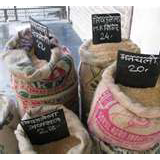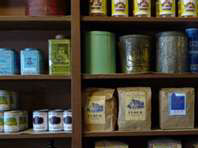The What and Why of Storing Wheat
By Patty Liston
 One of the food basics of food storage is wheat. It is estimated that 400 pounds of grains in the form of wheat, oats, and rice, is what would is needed for one adult to subsist on for one year. This may seem like a lot of grain, but think of what you and/or your family may consume during a week: cereals, sandwiches, cookies, toast, maybe a pizza crust. If there was no bread or other grain products in your supermarket due to a disaster, what will you eat?
One of the food basics of food storage is wheat. It is estimated that 400 pounds of grains in the form of wheat, oats, and rice, is what would is needed for one adult to subsist on for one year. This may seem like a lot of grain, but think of what you and/or your family may consume during a week: cereals, sandwiches, cookies, toast, maybe a pizza crust. If there was no bread or other grain products in your supermarket due to a disaster, what will you eat?
 Bread is a staple in most family homes. A typical loaf is 9 inches long. Eliminating the end crusts, (which as my mother always said, made your hair curly!), you are left with around 16 pieces of bread. Two pieces are needed to make a sandwich, so one loaf makes 8 sandwiches. One loaf of home-made bread takes one pound of grain; wheat, wheat and white flower mix, wheat and oats, etc. Given those numbers, it would take 50 pounds of wheat to make 50 loaves of bread - assuming you were using whole wheat without any other grain added. So, how much wheat should you store? The suggested amount is 200# per person, per year, with the other 200# stored in a mix of rice and oats. Remember that these are just estimates.
Bread is a staple in most family homes. A typical loaf is 9 inches long. Eliminating the end crusts, (which as my mother always said, made your hair curly!), you are left with around 16 pieces of bread. Two pieces are needed to make a sandwich, so one loaf makes 8 sandwiches. One loaf of home-made bread takes one pound of grain; wheat, wheat and white flower mix, wheat and oats, etc. Given those numbers, it would take 50 pounds of wheat to make 50 loaves of bread - assuming you were using whole wheat without any other grain added. So, how much wheat should you store? The suggested amount is 200# per person, per year, with the other 200# stored in a mix of rice and oats. Remember that these are just estimates.
Most of us wouldn't know what to do with 200 pounds of wheat kernels if you offered us hundred dollar bills for some answers. We don't need to have all of the answers right now. We just need to work together to begin at the beginning: What kind of wheat do I store?
Types of Wheat
 The most common types of wheat that are grown here in the U.S. are red and white wheat.
The most common types of wheat that are grown here in the U.S. are red and white wheat.
There is hard red spring, hard red winter, hard white winter, soft white spring and soft white winter. Overwhelmed yet? Don't worry. You can decide which wheat to purchase by determining what you will do with it.
Hard Red Winter Wheat: this wheat has more gluten in it which means that it is perfect for making breads. It expands, and stretches which makes this a hearty loaf: think pioneers who would put thick gravy on a slice and call it dinner. Some cooks use this cooked wheat as a way to extend the red meat they may be serving. This wheat is high in protein and fiber.
Hard White Winter Wheat: is considered to have a more "delicate" flavor. This wheat is perfect for making your grandmother's famous fluffy, light rolls, bread and even scones. Like the red wheat, the white wheat may also be used to extend white meats, such as pork and chicken. Also like the red, this too is high in protein and fiber.
Soft White Spring and Winter Wheat: both of these grains have kernels that are larger and fatter than the hard red and whites. They are softer in texture when cooked and have a lower gluten consistency. This makes these soft wheat's perfect for making pastries, pie crusts, cakes, crackers and/or cereals, but not are not dense enough for making breads.
Storing Wheat
 Wheat has been found in earthen vessels that date back to the early Egyptians and was still edible! Bottom line: wheat will last, and last.
Wheat has been found in earthen vessels that date back to the early Egyptians and was still edible! Bottom line: wheat will last, and last.
Some things you should know about storing wheat in your home:
• Store the wheat as kernels because it will last longer. Take out just what you need to grind into flour, and leave the rest securely sealed in your container.
 • Store in buckets that are specifically for food storage or "food grade" quality. Most preparedness stores sell these, along with tight fitting lids.
• Store in buckets that are specifically for food storage or "food grade" quality. Most preparedness stores sell these, along with tight fitting lids.
• To keep the moisture content of the wheat less than 10 percent, store it in a cool, dry place.
 • Exposure to oxygen may cause some forms of bacteria to grow in your wheat. Purchasing oxygen absorbers will keep this exposure to a minimum.
• Exposure to oxygen may cause some forms of bacteria to grow in your wheat. Purchasing oxygen absorbers will keep this exposure to a minimum.
• Don't store the containers directly on a cement floor. Store on a wood shelf, or put wooden planks on your floor, and store the buckets on top of these.
Next week I will discuss ways of grinding the wheat, and what to do with it once you are looking at a pile of wheat flour!

